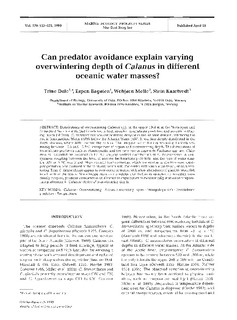| dc.description.abstract | Distributions of overwintering Calanus spp. in the upper 1000 m in the Norwegian and Greenland Seas were studied in relation to hydrography, invertebrate predators and acoustic scattering layers (38 kHz). C, finmarchicus was concentrated deepest in the Atlantic domain, inhabiting the Arctic Intermediate Water (AIW) below the Atlantic Water (AW). It was less deeply distributed in the Arctic domain, where AMI reached the surface. The temperature of the overwintering habitats was mainly between -0.5 and +0.5 degrees C, irrespective of region and overwintering depth. The distributions of invertebrate predators such as chaetognaths and the carnivorous copepods Euchaeta spp. and Chiridius sp. provided no explanation for the varying vertical distributions of C. finmarchicus. A conspicuous coupling between the level of acoustic backscattering (38 kHz) and the type of water mass (i.e. AW or AIW) was found. High acoustic backscattering, which we ascribe to planktivorous mesopelagic fishes, was confined to the relatively warm AW. The colder AIW was almost devoid of backscattering. Thus C, finmarchicus appear to overwinter in waters with a low abundance of planktivorous fish in all parts of the ocean. Since temperature and predator distribution as revealed by acoustics were closely coupled, predator avoidance is an alternative explanation to metabolically motivated temperature preference in Calanus' choice of overwintering depth. | en |
